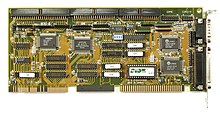| VESA Local Bus | |
 Multi-I/O-Controller with 1×IDE/SCSI-2/FDD/parallel/2×RS232/Game | |
| Year created | 1992 |
|---|---|
| Created by | VESA |
| Superseded by | PCI (1993) |
| Width in bits | 32 |
| No. of devices | 3[1] |
| Speed | 25–40 MHz |
| Style | Parallel |
| Hotplugging interface | no |
| External interface | no |
The VESA Local Bus (usually abbreviated to VL-Bus or VLB) is a short-lived expansion bus introduced during the i486 generation of x86 IBM-compatible personal computers. Created by VESA (Video Electronics Standards Association), the VESA Local Bus worked alongside the then-dominant ISA bus to provide a standardized high-speed conduit intended primarily to accelerate video (graphics) operations. VLB provides a standardized fast path that add-in (video) card makers could tap for greatly accelerated memory-mapped I/O and DMA, while still using the familiar ISA bus to handle basic device duties such as interrupts and port-mapped I/O. Some high-end 386DX motherboards also had a VL-Bus slot.
- ^ Schuytema, Paul. "Infinite expansion. (computer buses)". Atari Magazine, COMPUTE! ISSUE 158 / NOVEMBER 1993 / PAGE 68. Retrieved May 27, 2019.